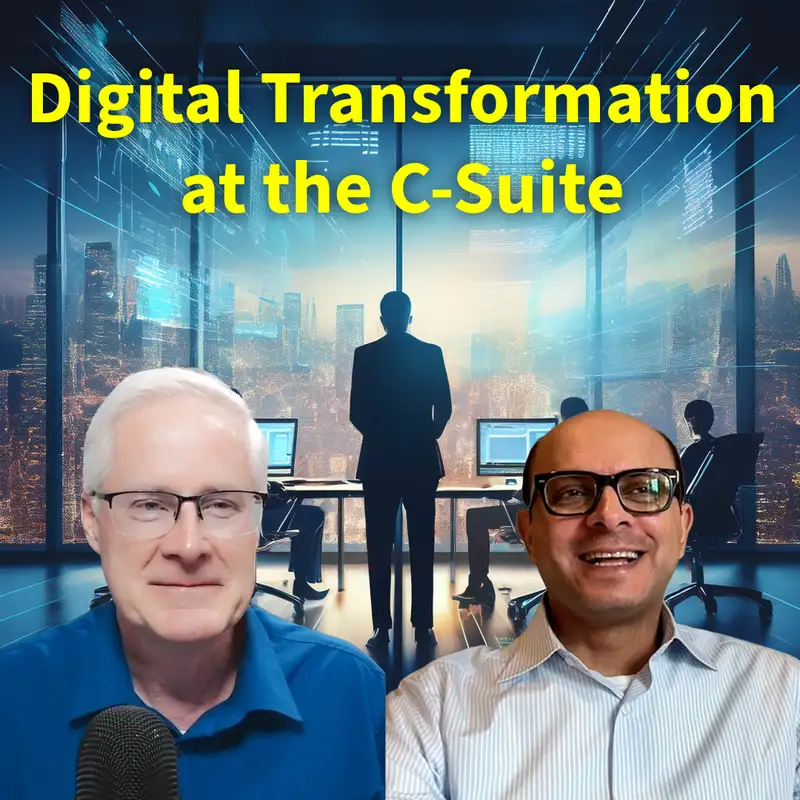#260 Navigating Digital Transformation: Insights from the C-Suite
In this episode, Dr. Darren interviews Mohib Yousufani, a partner at PwC. They discuss the complexities of digital transformation, particularly from the perspective of the C-suite. He emphasizes the importance of understanding customer needs, navigating legacy systems, and the challenges large organizations face in adapting to rapid market changes. The discussion also highlights the significance of addressing process debt, which can manifest as outdated software, redundant processes, or inefficient workflows, breaking down silos, and leveraging AI for innovative pricing strategies. Ultimately, the conversation underscores the intertwined nature of culture and process in successful transformation efforts.
Takeaways
* Digital transformation is messy and requires a strategic approach. * C-suite involvement is crucial for successful transformation. * Legacy systems and processes hinder agility in organizations. * Speed of transformation is essential in a competitive landscape. * Process debt is often overlooked but critical to address. * Breaking down silos can lead to significant efficiency gains. * AI and data science can revolutionize pricing strategies. * Cultural change is necessary for effective process change. * Organizations must measure value to improve processes. * Transformations should be part of a broader strategic mandate.
Takeaways
* Digital transformation is messy and requires a strategic approach. * C-suite involvement is crucial for successful transformation. * Legacy systems and processes hinder agility in organizations. * Speed of transformation is essential in a competitive landscape. * Process debt is often overlooked but critical to address. * Breaking down silos can lead to significant efficiency gains. * AI and data science can revolutionize pricing strategies. * Cultural change is necessary for effective process change. * Organizations must measure value to improve processes. * Transformations should be part of a broader strategic mandate.
Digital transformation is a highly relevant topic for technologists and business leaders alike, particularly as the pace of technological advancement continues to accelerate. The business landscape is changing rapidly, and organizations must adapt to stay competitive. Companies face increasing pressure from market disruption, shifting consumer preferences, and the need for agile responses. Embracing digital transformation is not just about implementing new technologies; it involves rethinking processes, strategies, and even corporate cultures to capture value from digital investments truly.
The Three Pillars of Digital Transformation
To successfully navigate this complex terrain, organizations need to focus on three crucial components: understanding where to begin, evaluating the overarching business model, and simplifying organizational structures. The direction of any transformation begins with a deep understanding of the desired outcomes. Is the focus on improving profitability, enhancing customer engagement, or fostering shareholder value? Once the strategic goals are crystal clear, companies can identify specific initiatives and technologies that align with those objectives.
Taking a holistic approach is key—not every solution lies in simply upgrading to the latest software, be it SAP, Oracle, or Salesforce. Technology is often the easiest aspect to change, but it should not be treated as an isolated initiative. Instead, it must be integrated into a larger strategy that reforms business processes. The most successful organizations assess their entire ecosystem, considering customer interactions and back-end operations such as supply chain management or HR. By dissecting these components into manageable parts and thereby targeting specific 'value drops' such as reducing customer wait times or improving inventory management, businesses can generate tangible returns on investment.
Breaking Down Silos: The Importance of Cross-Functional Collaboration
For many organizations, traditional silos within departments can hinder effective transformation. It’s common for HR or finance functions to operate in disjointed manners, complicating what could be streamlined processes. Integrating disparate functions—even when they fall under different operational umbrellas—can create efficiencies that are crucial for a nimble operation. Instead of implementing scattershot improvements to individual processes, organizations should aim for an 'end-to-end view', a comprehensive understanding of the entire workflow from start to finish, to ensure all processes are optimized and aligned with the organization's goals.
This cross-functional collaboration can significantly increase efficiency, potentially up to 30%, and significantly uplift employee experience. Instead of simply deploying point solutions that may yield marginal gains, companies should focus on comprehensive reengineering that examines entire workflows. When organizations can visualize how different pieces fit together in a cohesive structure, they’re better positioned to innovate, cut waste, and ultimately deliver greater value to customers and shareholders alike.
Leveraging Emerging Technologies Wisely
The allure of emerging technologies, especially generative AI and machine learning, is undeniable in the current landscape. However, organizations must resist the temptation to adopt these shiny new tools without a foundational strategy. Implementing the latest tech for its own sake does not guarantee success. The focus should be on how these technologies can be utilized to address specific business challenges, streamline processes, and enhance decision-making.
Generative AI can revolutionize aspects like pricing models and customer insights by utilizing vast pools of data to drive smarter decisions. Yet, the anticipated benefits may remain elusive without proper alignment to strategic goals and adequate measures to support change. Companies that employ a 'thoughtful approach' to integrating new technologies, which involves thorough planning, clear communication, and continuous evaluation, recognizing their potential to innovate processes and provide data-driven insights, are more likely to achieve significant ROI.
Intent and Strategy Matter
Digital transformation is an ongoing journey requiring deliberate intent and strategic planning. Organizations that embrace this journey—not just as a technology upgrade, but as a business necessity—position themselves for success in a hyper-competitive landscape. It involves breaking down silos, re-evaluating the business model, and fostering a culture of collaboration and adaptability.
As organizations continue to navigate digital transformation, focusing on these foundational elements can help them keep up with rapid change and thrive in the dynamic marketplace. Achieving success is not merely about adopting new tools, but rather about understanding how those tools can be integrated into holistic processes aimed at capturing real value within the organization.
Are you ready to embrace your digital transformation? Consider evaluating your strategies, engaging cross-functional teams, and adopting technologies to truly harness their potential.

